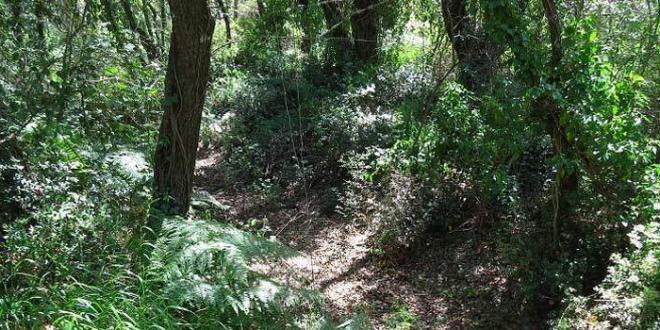
“Difatti da quando Cesare pensò di deviare addirittura il Tevere verso Terracina e farne il canale raccoglitore delle acque Pontine” (V. Plutarco vita Caes. 58 )
Il sentiero C è il più lungo della zona e raccoglie insieme molti dei principali temi degli altri tracciati.
Si segue idealmente “la Fossa Augusta”, che oggi possiamo paragonare ai canali di bonifica che costeggiamo lungo il sentiero.
La tradizione storica indica nella “Fossa Augusta” un poderoso progetto idraulico di canalizzazione, prima pensato da Cesare, come ricorda Plutarco, e poi attribuito a Nerone che avrebbe iniziato i lavori di canali che, sfruttando le numerose lagune costiere, avrebbero collegato Ostia al Lago d’Averno per 160 miglia, per consentire una sicura navigazione interna durante tutto l’anno. Tacito dice che lo scavo fu avviato, ma sia lui che Svetonio ne parlano come l’impresa più pazzesca messa in atto da Nerone. Tracce di questa grandiosa opera, “la Fossa Neronis” o “Cavo d’Augusto”, che non fu mai portata a termine, restano proprio tra i laghi di Caprolace e di Paola e sotto il promontorio da Torre Paola a Rio Torto.
Ma la “Fossa Augusta” è qui il filo conduttore di una storia che si snoda nel tempo attraverso numerosi segni urbani, agricoli, idraulici e naturali che Il nostro itinerario segue a partire da quell’antico progetto.
Luoghi di inestimabile valore ambientale, le lagune costiere sono tra i biotopi più ricchi di biomassa ovvero di quantità di vita. Enormi quantità di risorse alimentari per l’uomo dalla preistoria ad oggi, ricavate soprattutto attraverso la pesca e la caccia. Dalla preistoria ai Romani, dai monaci al nobile Casato dei Caetani dalla fine del ‘200 ai primi decenni del ‘900. Un territorio ricco e mortifero allo stesso tempo. Uomini del paleolitico, romani, monaci, nobili, pescatori, cacciatori, butteri, briganti, pirati, fuggiaschi, oppure mignattari, raccoglitori di rane… e ancora scienziati, bonificatori, mezzi meccanici, città nuove…qui l’uomo ha sempre cercato di vivere al meglio quanto la preziosa ma difficile natura del luogo ha sempre proposto.
Una storia, una natura da vivere appieno lungo questo sentiero, fino ad affacciarsi al termine, valicando la duna, dopo aver passato i “Pantani dell’Inferno, sul maestoso panorama del mare!
Buon cammino!
 English version
English version

“In fact, when Cesar intended to actually divert the Tiber towards Terracina and make it a canal that collects the Pontine waters” (cf. Plutarch, Life of Julius Caesar, 58).
Historical tradition indicates the “Fossa Augusta” as a formidable hydraulic canalization project, which was first conceived by Caesar, as Plutarch recalls, and then attributed to Nero who supposedly began the work of canals which, by taking advantage of the numerous coastal lagoons, would connect Ostia to the Averno Lake for 160 miles, in order to allow safe inland navigation throughout the whole year. Tacitus says that the excavation did begin, but both him and Suetonius mention it as the craziest endeavour implemented by Nero. Traces of this magnificent work, “the Fossa Neronis” or “Cavo d’Augusto”, which was never completed, still remain right between the lakes of Caprolace and Paola beneath the promontory from Torre Paola to Rio Torto.
However, this is where the “Fossa Augusta” is the common thread of a story that unwinds over time through numerous urban, agricultural, hydraulic and natural signs which our itinerary will follow, starting from that ancient project. Places of inestimable environmental importance, the coastal lagoons are one of the biotopes with the most biomass, that is, quantity of living organisms. Vast quantities of food resources for man from prehistory to the present day, obtained above all by fishing and hunting. From prehistory to the Romans, from the monks to the noble Caetani family from the end of the 13th century to the first decades of the 20th century. It is a territory that is rich and deadly at the same time. Men of the Palaeolithic, Romans, monks, nobles, fishermen, hunters, herdsmen, bandits, pirates, fugitives, or leech and frog collectors… and even scientists, reclamations, mechanical machines, new cities… this is where man has always tried to make the most of what the precious yet difficult nature of the place has always offered.
It is a story, nature to be fully enjoyed along this trail, where in the end, after crossing the dune and the “Pantani dell’inferno”, we are faced with the breath-taking view of the sea!
Happy walking!
 Radio Onda Blu La Radio di Sabaudia con Musica, Notizie, Eventi e Servizi
Radio Onda Blu La Radio di Sabaudia con Musica, Notizie, Eventi e Servizi 

